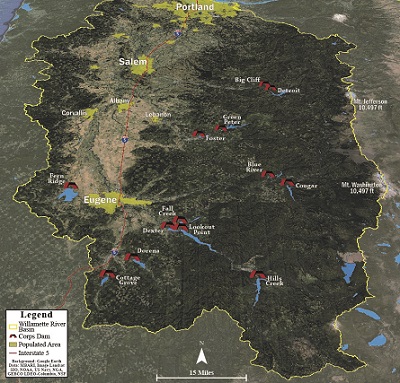 The Willamette Basin is Oregon's largest river basin. It contains nearly 70 percent of Oregon’s population, its most highly productive agricultural land, and significant habitat for anadromous fish populations.
The Willamette Basin is Oregon's largest river basin. It contains nearly 70 percent of Oregon’s population, its most highly productive agricultural land, and significant habitat for anadromous fish populations.
The Willamette River and its tributaries make it possible to support today's population and generate hydropower. The vast majority of people in the basin are supported by municipal and industrial public water systems that meet basic human needs, provide fire protection, and support business and industrial development. In communities near the reservoirs, recreational uses are an important contribution to local economies.
Willamette water also supports agricultural productivity and a healthy natural environment. Irrigation enhances the role that agriculture plays in Oregon's economy and keeps farming as a feasible vocation for future generations. Fish and wildlife require access to clean water to support all aspects of their life cycles.
Because water is so important to every resident of the basin, and to other Oregon residents who rely on a strong Willamette Valley economy, the stewardship of its water resources is critical to Oregon's future.
Population growth, increasing development, expanding irrigation and the listing of threatened or endangered fish species have created demands for increased water supplies in the Willamette Valley.
Future water supply options in the Willamette River basin are constrained by existing state and federal laws. For example, access to new surface
water rights in sections of the mainstem Willamette River and most major tributaries is limited to a small set of uses to protect existing water rights and public instream uses. Groundwater is also limited or restricted in several areas of the basin.